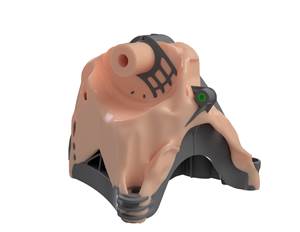DuPont Celebrates 80th Anniversary of Nylon
If guitars, piano and voice shape music; and email, texts and blogs shape how we communicate; then nylon shapes ideas, says DuPont.

Nylon, the breakthrough material invented by DuPont researcher Wallace Carothers in 1935 is credited for making many consumer goods—stockings, toothbrushes, hand-held devices—more affordable, attractive and accessible to everyone globally. The 80-year-old lightweight material is frequently used to replace metal, lowering weight and cost and inviting design freedom and parts integration.
Nylon is known to have revolutionized the textile/fashion industry. But the material’s versatility and strength, backed by science to coax out added performance and a global development network to support customers, proved to be the formula that earned nylon its reputation and its place as one of DuPont’s most successful products. “If the performance launched the polymer, then design freedom helped it grow and adaptability keeps it young. As long as designers can dream it, we can help them manufacture it,” says DuPont Performance Polymers president Patrick Lindner. Here are some key nylon milestones:
1935—Dr. Wallace Carothers discovered nylon, the world’s first true synthetic fiber, and one of DuPont’s most successful products. Carothers was lured from Harvard to DuPont in 1927 with the promise that he could pursue basic research, specifically looking at polymers—molecules with long, repeating chain structures. During his nine years with DuPont, Carothers filed for more than 50 patents.
1939—Nylon was commercialized remarkably quick. After determining that low-cost production was possible and settling on a target market (women’s hosiery), DuPont built a full-scale nylon plant in Seaford, Del., and began commercial production in 1939. From the time it went on sale to the general public in May 1940, nylon hosiery was a huge success: women lined up at stores across the country to obtain the precious goods.
1941—Era of metals replacement began with the development of nylon into an engineering polymer. During World War II, the U.S. government advised replacing metals with plastics whenever possible and DuPont began large-scale production of its new nylon resin for use in gears, cams, valves and ball bearings.
1954—DuPont trademarked the resin Zytel nylon and marketed it as a lightweight, heavy-duty industrial and engineering plastic resistant to hear and corrosive chemicals. DuPont’s research into high-performance polymers extended beyond nylons to include acetals and polyesters.
1968—DuPont introduced glass-reinforced nylon, improving its already impressive list of properties. The coming decades would see growing adoptions of nylon to replace metal in radiator end tanks, engine cooling fans, wire harnesses, emission-control devices and power-steering reservoirs.
1973—DuPont researcher Bennet Epstein blended nylon with small amounts of other resins to make “Super Tough” DuPont Zytel ST. Its introduction during the 1973-74 oil shortage proved timely as automobile manufacturers used it in gas tanks, interior panels and engine components to reduce vehicle weight and increase gas mileage. The success of Zytel ST in automobiles soon led to new applications in appliances, wire insulation, sporting gear and home furnishings.
1992—After years of development and testing, General Motors adopted Zytel nylon for one of its most popular and reliable engines—the 3800. This marked the first high-volume commercial adoption of nylon in an air-intake manifold and paved the way for a wholesale global shift from metal to plastic in manifolds over the next decade. By the time the venerable GM3800 engine retired in 2008, the 65% reduction in mass vs. aluminum eliminated the need for more than 2.6-million barrels of oil.
1994—DuPont introduced Zytel HTN to cost-effectively bridge the performance gap between conventional engineering resins and high-end specialty polymers. Zytel HTN PPA grades retain stiffness, strength and mechanical properties despite exposure to high temperatures, chemicals and moisture, making them ideal for automotive underhood components and systems, connectors and bushings. Structural grades of Zytel HTN help provide larger display areas when used in backbones for cell phones, PDAs and other hand-held devices.
2009—A four-year collaboration between DENSO and DuPont Performance Polymers resulted in a plant-derived DuPont Zytel RS 610 nylon resin that debuted on a Toyota Camry radiator end tank. The development earned the development team a “Most Innovative Use of Plastics” award from the Society of Plastics Engineers (SPE) Automotive Division. The renewable sourced polyamide family, which also includes Zytel RS nylon 1010, is made of 20% to 100% by weight of renewable content derived from sebacic acid, a non-food crop.
2010—DuPont Performance Polymers launched Zytel PLUS nylon, which delivers excellent performance levels and importantly maintains those excellent performance levels much longer than traditional nylons despite exposure to hot oil, hot air, calcium chloride and other aggressive automotive chemicals.
2015 and Beyond:
Automotive—DuPont continues to expand the portfolio of Zytel, Zytel HTN, Zytel PLUS and specialty resins to help automakers reduce weight and improve efficiency to cost-effectively lower emissions and improve fuel economy.
Consumer Electronics—New Zytel HTN grades provide hand-held device designers with greater freedom so they can continue to refresh the look, feel and upgrade performance, while delivering a better environmental footprint with renewably sourced grades.
Design Freedom—DuPont’s science continues to adapt the material’s functionality combined with the material’s ease of processing and DuPont global design expertise can help design engineers shape their ideas for components and products used in most every industrial and consumer product.

Related Content
Additive Fusion Technology Optimizes Composite Structures for Demanding Applications
9T Labs continues to enhance the efficiency of its technology, which produces composite parts with intentionally oriented fibers.
Read MoreNew CRM Streamlines Quoting for Automotive Molder
Eliminating the need to contact each supplier for every individual quote, a new CRM for automotive supplier Axiom Group tracks past quotes as well as industry history to generate fast, reliable RFQs and more.
Read MoreAutomotive Awards Highlight Emerging Technologies
Annual SPE Automotive event gives nods to several ‘firsts’ as well as sustainability.
Read MoreDesign Optimization Software Finds Weight-Saving Solutions Outside the Traditional Realm
Resin supplier Celanese turned to startup Rafinex and its Möbius software to optimize the design for an engine bracket, ultimately reducing weight by 25% while maintaining mechanical performance and function.
Read MoreRead Next
Lead the Conversation, Change the Conversation
Coverage of single-use plastics can be both misleading and demoralizing. Here are 10 tips for changing the perception of the plastics industry at your company and in your community.
Read MoreSee Recyclers Close the Loop on Trade Show Production Scrap at NPE2024
A collaboration between show organizer PLASTICS, recycler CPR and size reduction experts WEIMA and Conair recovered and recycled all production scrap at NPE2024.
Read MoreBeyond Prototypes: 8 Ways the Plastics Industry Is Using 3D Printing
Plastics processors are finding applications for 3D printing around the plant and across the supply chain. Here are 8 examples to look for at NPE2024.
Read More


























